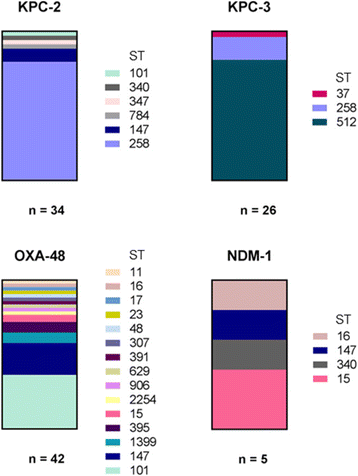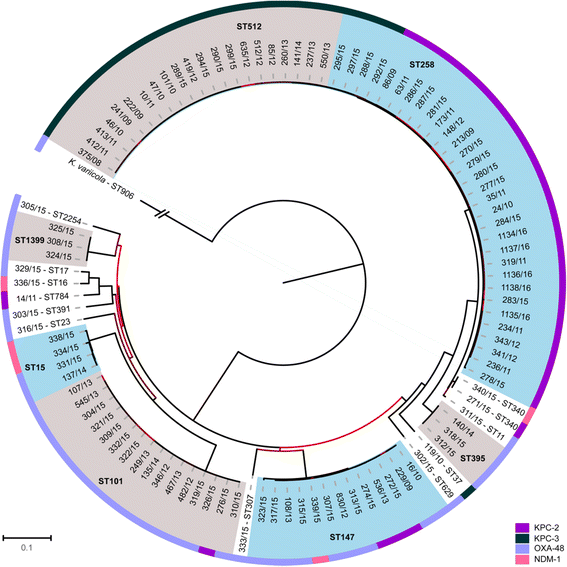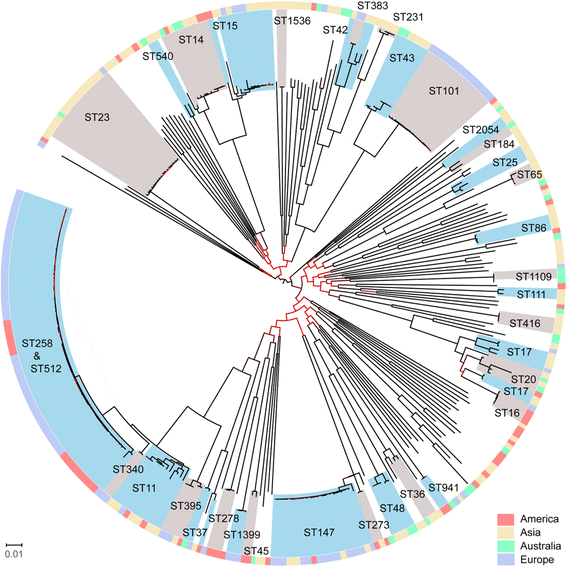Genome-based analysis of Carbapenemase-producing Klebsiella pneumoniae isolates from German hospital patients, 2008-2014
- PMID: 29744043
- PMCID: PMC5930415
- DOI: 10.1186/s13756-018-0352-y
Genome-based analysis of Carbapenemase-producing Klebsiella pneumoniae isolates from German hospital patients, 2008-2014
Abstract
Background: By using whole genome sequence data we aimed at describing a population snapshot of carbapenemase-producing K. pneumoniae isolated from hospitalized patients in Germany between 2008 and 2014.
Methods: We selected a representative subset of 107 carbapenemase-producing K. pneumoniae clinical isolates possessing the four most prevalent carbapenemase types in Germany (KPC-2, KPC-3, OXA-48, NDM-1). Isolates were processed via illumina NGS. Data were analysed using different SNP-based mapping and de-novo assembly approaches. Relevant information was extracted from NGS data (antibiotic resistance determinants, wzi gene/cps type, virulence genes). NGS data from the present study were also compared with 238 genome data from two previous international studies on K. pneumoniae.
Results: NGS-based analyses revealed a preferred prevalence of KPC-2-producing ST258 and KPC-3-producing ST512 isolates. OXA-48, being the most prevalent carbapenemase type in Germany, was associated with various K. pneumoniae strain types; most of them possessing IncL/M plasmid replicons suggesting a preferred dissemination of blaOXA-48 via this well-known plasmid type. Clusters ST15, ST147, ST258, and ST512 demonstrated an intermingled subset structure consisting of German and other European K. pneumoniae isolates. ST23 being the most frequent MLST type in Asia was found only once in Germany. This latter isolate contained an almost complete set of virulence genes and a K1 capsule suggesting occurrence of a hypervirulent ST23 strain producing OXA-48 in Germany.
Conclusions: Our study results suggest prevalence of "classical" K. pneumonaie strain types associated with widely distributed carbapenemase genes such as ST258/KPC-2 or ST512/KPC-3 also in Germany. The finding of a supposed hypervirulent and OXA-48-producing ST23 K. pneumoniae isolates outside Asia is highly worrisome and requires intense molecular surveillance.
Keywords: Hypermucoviscous; Hypervirulent; K1 capsule; KPC; OXA-48; ST23; ST258.
Conflict of interest statement
Not applicable.The authors declare that they have no competing interests.Springer Nature remains neutral with regard to jurisdictional claims in published maps and institutional affiliations.
Figures




References
-
- ECDC . Annual report of the European antimicrobial resistance surveillance network (EARS-net) Stockholm: European Centre for Disease Prevention and Control (ECDC); 2017. Antimicrobial resistance surveillance in Europe 2016; 5. Annual report of the European antimicrobial resistance surveillance network (EARS-net)
-
- Pfennigwerth N. Report of the National Reference Centre for gram-negative nosocomial pathogens, 2016. Epidemiologisches Bull. 2017;26:5.
-
- Kaase M, Pfennigwerth N. Report from the National Reference Centre for gram-negative nosocomial pathogens, 2015. Epidemiologisches Bull. 2016;41(25):5.
-
- Kaiser T, Finstermeier K, Hantzsch M, Faucheux S, Kaase M, Eckmanns T, Bercker S, Kaisers UX, Lippmann N, Rodloff AC, et al. Stalking a lethal superbug by whole-genome sequencing and phylogenetics: influence on unraveling a major hospital outbreak of carbapenem-resistant Klebsiella pneumoniae. Am J Infect Control. 2017;46(1):54–59. 10.1016/j.ajic.2017.07.022. - PubMed
-
- Carstens A, Kepper U, Exner M, Hauri AM, Kaase M, Wendt C. Plasmid-mediated multispecies outbreak with carbapenemase-resistant Enterobacteriaceae. Epidemiologisches Bull. 2014;47:5.
Publication types
MeSH terms
Substances
LinkOut - more resources
Full Text Sources
Other Literature Sources

